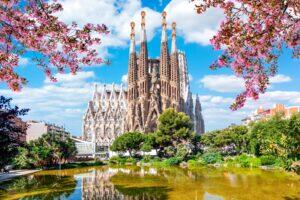Fodor's Expert Review Sarrià
Originally a cluster of farms and country houses, Sarrià is now a premier residential neighborhood overlooking Barcelona from the hills. Start an exploration at the main square, Plaça de Sarrià—the site of Tuesday antique and bric-a-brac markets; Sunday morning sardana dances; Christmas pageants; and concerts, book fairs, and artisanal food and wine events at various times during the year. The 10th-century Romanesque Church of Sant Vicenç dominates this square, and its bell tower, illuminated on weekend nights, is truly impressive. Across Passeig de la Reina Elisenda from the church is the Mercat de Sarrià, a Moderniste gem built in 1911, with its intricate brickwork facade, wrought-iron girders and stained-glass windows.
On the cobblestone street behind the Mercat is the Centre i Teatre de Sarrià ( Pare Miquel de Sarrià 8 93/03–9772) a fixture in the village for the past 125 years, with a lovely... READ MORE
Originally a cluster of farms and country houses, Sarrià is now a premier residential neighborhood overlooking Barcelona from the hills. Start an exploration at the main square, Plaça de Sarrià—the site of Tuesday antique and bric-a-brac markets; Sunday morning sardana dances; Christmas pageants; and concerts, book fairs, and artisanal food and wine events at various times during the year. The 10th-century Romanesque Church of Sant Vicenç dominates this square, and its bell tower, illuminated on weekend nights, is truly impressive. Across Passeig de la Reina Elisenda from the church is the Mercat de Sarrià, a Moderniste gem built in 1911, with its intricate brickwork facade, wrought-iron girders and stained-glass windows.
On the cobblestone street behind the Mercat is the Centre i Teatre de Sarrià ( Pare Miquel de Sarrià 8 93/03–9772) a fixture in the village for the past 125 years, with a lovely 340-seat theater (it has red plush seats and gilded fixtures) that hosts a wide range of programs, films, dance performances, and drama—and two or three times a year, professional opera. The Centre also has an indoor café and a pleasant terrace fronting the theater, just right for a short break in your village ramble.
From the square, cut through the Placeta del Roser to the left of the church to the elegant Town Hall (1896) in the Plaça de la Vila. Note the buxom bronze sculpture of Pomona, goddess of fruit, by famed Sarrià sculptor Josep Clarà (1878–1958). Follow tiny Carrer dels Paletes, to the left of the Town Hall (the saint enshrined in the niche is Sant Antoni, patron saint of paletes, or bricklayers). Turn right on Major de Sarrià, the High Street of the village and then left onto Carrer Canet. The two-story row houses on the right—built for workers on the village estates—and the houses opposite at Nos. 15, 21, and 23 are among the few remaining original village structures in Sarrià.
Turn right at the first corner on Carrer Cornet i Mas and walk two blocks down to Carrer Jaume Piquet. On the left is No. 30, Barcelona's most perfect small-format Moderniste house. Thought to be the work of architect Domènech i Montaner, it features faux-medieval upper windows, wrought-iron grillwork, floral and fruited ornamentation, and organically curved and carved wooden doors either by or inspired by Gaudí himself. The next stop down Cornet i Mas is Sarrià's prettiest square, Plaça Sant Vicens, a leafy space ringed by old Sarrià houses and centered on a statue of Sarrià's patron St. Vicenç, portrayed (as always) beside the millstone used to sink him to the bottom of the Mediterranean after he was martyred in Valencia in AD 302. Can Pau, the café on the lower corner with Carrer Mañé i Flaquer, is the local hangout, once a haven for authors Gabriel García Marquez and Mario Vargas Llosa, who lived in Sarrià in the late 1960s and early 1970s.
Other Sarrià landmarks include the two Foix de Sarrià pastry shops, one at Plaça Sarrià 12–13 and the other at Major de Sarrià 57, above Bar Tomás. The late J. V. Foix (1893–1987), son of the shop's founder, was one of the great Catalan poets of the 20th century, a key player in keeping the Catalan language alive during the 40-year Franco regime. The shop on Major de Sarrià has a bronze plaque identifying the house as the poet's birthplace and inscribed with one of his most memorable verses, translated as, "Every love is latent in the other love / every language is the juice of a common tongue / every country touches the fatherland of all / every faith will be the lifeblood of a higher faith."
READ LESS








